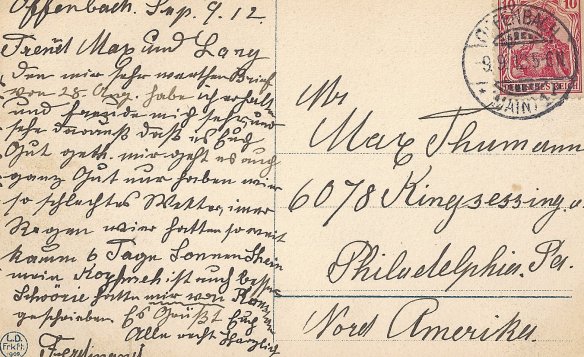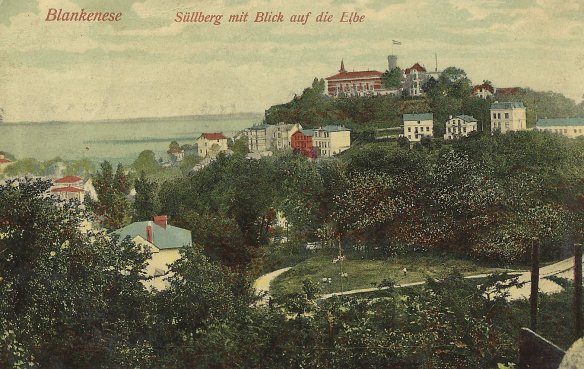When I last wrote in this series (a mere two and a half years ago), I was halfway through a pile of postcards that I titled “Ferdinand’s German Road Trip.” [See the link at the end to view past posts.] In this series, Ferdinand Müller, a German-born naturalized U.S. citizen living in Philadelphia, has returned to Germany in 1912 for a visit. Along the way, he writes to his friends back home, Max and Laura Thumann (my great-aunt). 101 years later, Laura’s album of postcards found its way to me. Viewing them is like taking a trip back in time!
This week’s card is dated three days his visit to Burg Eltz. (Ferdinand’s “home base” for the trip is Offenbach.)
23 September 1912 ~ Offenbach, Germany

Front: Schützen-Brunnen, Zoologischer Garten, Frankfurt

Back: He may be at the zoo, but he has nothing to say about it!
The postcard reads:
Offenbach a/m 26.9.12
Eure Carte vom 13ten habe ich erhalten und freue mich jedes mal wen ich von Euch höre vielleicht komme ich auch mal nach Regensburg wir fahren sehr weit mit dem Auto. Schworg ist in München kommt zu mir nächstens. Ich fahre nach Darmstad morgen. Grüße an Alle Bekannten
Translation:
Offenbach a/m 26.9.12
I received your card from the 13th and rejoice every time I hear from you. Perhaps I will come to Regensburg sometime. We drive very far with the car. Schworg is in Munich and visits me soon. I am going to Darmstadt tomorrow. Greetings to all
In these notes to his friends, Ferdinand has continually been grateful for their communication to him while he was away (what I wouldn’t give to have the other half of the conversation!). He also writes frequently of traveling by car, which in 1912 would have been quite the luxurious novelty. Again he references a mutual friend by the nickname “Schworg” and keeps them updated on his next travel spot. What he fails to say, however, is anything about his trip to the zoo in Frankfurt which is pictured on the postcard!
The card depicts the Schützen-Brunnen, a fountain at the zoo that was erected in 1894 by sculptor Rudolf Eckhardt. It stood nearly 46 feet high and was a symbol for the still-young German empire under Kaiser Wilhelm. The statue/fountain was inaugurated on August 24, 1894 in memory of the Bundesschießen, a sports shooting competition, which was held in Frankfurt in 1862 and 1887.

Another view of the Schutzen-brunnen
But, as we have discovered in our own country, even large statues do not withstand time. In this case, it wasn’t politics that toppled the massive monument, but economic-political reasons. It was destroyed due to “Metallspende des deutschen Volkes” – “Metal Donation by the German People” – which took place during both wars. Amazingly, it survived World War 1 unscathed. But in 1940, the reich needed more metal for weapons. Statues, church bells, and anything made of metal (trophies, flagpoles, lids on beer steins) was donated to be melted down. And it it wasn’t donated, it was a capital offense!
And so, the city of Frankfurt lost the Schützen-Brunnen. It makes me wish that Ferdinand had more to say about it. Or the zoo itself, which was founded in 1858 and is the second oldest zoo in Germany (after Berlin’s).
Part 12 of a 22-part series of Postcards from Ferdinand































